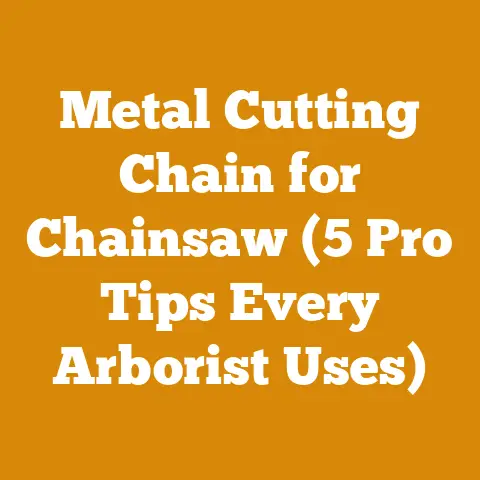Countyline 25 Ton Log Splitter Review (Expert Tips & Truths)
Having spent over 20 years felling trees, processing timber, and heating my home with wood, I’ve seen countless log splitters come and go. I even managed to turn a small, neglected patch of woodland into a sustainable firewood business that helped put my kids through college. Today, I’m going to share my in-depth review of the Countyline 25 Ton Log Splitter, packed with expert tips and honest truths. This isn’t just a spec sheet regurgitation; it’s a real-world assessment based on years of experience and a deep understanding of what makes a log splitter truly valuable.
What to Expect in This Review
I’ll cover everything from the initial setup and operation to long-term maintenance and potential problems. You’ll find practical tips on how to maximize the splitter’s efficiency, handle different types of wood, and ensure your safety while using it. My goal is to provide a resource that is both informative and actionable, helping you get the most out of your Countyline 25 Ton Log Splitter.
Why a 25 Ton Log Splitter?
A 25-ton log splitter sits in a sweet spot for many homeowners and small-scale firewood producers. It offers enough power to handle most common wood types and log sizes without being overkill (and over-priced) for smaller tasks. It’s a versatile machine that can tackle everything from seasoned oak to knotty elm, making it a popular choice for those who need a reliable and efficient way to process firewood.
Understanding the Countyline Brand
Countyline is a brand known for providing affordable, entry-level equipment, often sold through rural supply stores. While they might not have the same reputation as some of the higher-end brands, they often offer a good value proposition for those on a budget. However, it’s crucial to understand the trade-offs between price and performance, and that’s what I’ll be exploring in this review.
First Impressions and Initial Setup
My first impression of the Countyline 25 Ton Log Splitter was… well, it looked like a log splitter. The build quality appeared decent for the price point, but I immediately noticed a few areas that would need closer inspection.
Unboxing and Assembly
The splitter arrived partially assembled, which is typical for these machines. The assembly process was relatively straightforward, thanks to a reasonably clear instruction manual.
- Assembly Time: Approximately 2-3 hours.
- Tools Required: Wrenches (various sizes), pliers, hammer, safety glasses, work gloves.
- Key Assembly Steps: Attaching the wheels, tongue, and hydraulic hoses.
Tip: Before you even start, take inventory of all the parts to ensure nothing is missing. It’s frustrating to get halfway through the assembly process only to discover a crucial bolt is missing.
Checking Fluid Levels
Before starting the engine, it’s crucial to check the hydraulic fluid and engine oil levels. These machines are shipped dry, meaning you’ll need to add the appropriate fluids before operation.
- Hydraulic Fluid: Typically requires around 5-6 gallons of hydraulic fluid. Use a high-quality hydraulic fluid meeting the manufacturer’s specifications.
- Engine Oil: Check the engine manual for the correct oil type and quantity. Overfilling or using the wrong type of oil can damage the engine.
Caution: Always use a funnel when adding fluids to prevent spills. Hydraulic fluid can be messy and difficult to clean.
Initial Inspection
During the assembly process, take the time to inspect all the components for any signs of damage or defects. Check the welds, hoses, and fittings for leaks or cracks. It’s better to catch these issues early on than to have them surface during operation.
Observation: I noticed that some of the welds on the frame were a bit rough, but they seemed structurally sound. I also double-checked the hydraulic hose connections to ensure they were tight and leak-free.
Performance and Splitting Power
Now, let’s get to the heart of the matter: how well does the Countyline 25 Ton Log Splitter actually split wood? I put it through its paces with a variety of wood types and sizes to see how it performed under different conditions.
Wood Types Tested
- Seasoned Oak: Known for its density and hardness.
- Green Ash: Relatively easy to split when green, but gets tougher as it dries.
- Knotty Elm: A notorious challenge for any log splitter.
- Pine: Softwood, generally easy to split.
Splitting Cycle Time
The splitting cycle time is the amount of time it takes for the ram to extend and retract. A faster cycle time means you can process more wood in a given amount of time.
- Manufacturer Claim: Approximately 14 seconds.
- My Observation: The cycle time was closer to 16-18 seconds under load, which is a bit slower than advertised. This is a common occurrence with log splitters, as the actual cycle time can vary depending on the wood type and size.
Insight: While a few seconds might not seem like much, it can add up over the course of a day. If you’re processing a large amount of wood, a faster cycle time can significantly increase your productivity.
Splitting Force
The 25-ton rating indicates the maximum force the splitter can exert. However, it’s important to remember that this is a theoretical maximum. The actual splitting force will vary depending on the hydraulic pressure and the condition of the machine.
- Oak Performance: The splitter handled seasoned oak logs up to 18 inches in diameter with relative ease. Larger, more knotty logs required some maneuvering and repositioning.
- Elm Challenge: As expected, knotty elm proved to be the biggest challenge. The splitter struggled with some of the larger, more twisted pieces, requiring multiple attempts and careful positioning.
- Pine and Ash: Pine and green ash were no problem at all. The splitter sliced through these woods like butter.
Experience: I found that the key to splitting tough logs was to position them carefully, aiming for the weakest point. Sometimes, rotating the log slightly or splitting it from a different angle can make all the difference.
Horizontal vs. Vertical Operation
The Countyline 25 Ton Log Splitter can be operated in both horizontal and vertical positions. This is a useful feature, as it allows you to split larger, heavier logs without having to lift them onto the beam.
- Horizontal Mode: Ideal for smaller logs that are easy to lift.
- Vertical Mode: Essential for larger, heavier logs that would be difficult or impossible to lift.
Tip: When operating in vertical mode, make sure the log is securely positioned on the base plate before activating the ram. This will prevent the log from tipping over and potentially causing injury.
Engine Performance
The splitter is powered by a gasoline engine, typically around 6.5 horsepower. The engine provided adequate power for most splitting tasks, but it did bog down slightly when tackling the toughest oak and elm logs.
- Starting: The engine started easily, even in cold weather.
- Noise Level: The engine is relatively noisy, so ear protection is recommended.
- Fuel Consumption: Fuel consumption was reasonable, averaging around 1 gallon per 3-4 hours of operation.
Recommendation: Use high-quality gasoline and change the engine oil regularly to ensure optimal performance and longevity.
Key Features and Design
Let’s take a closer look at some of the key features and design elements of the Countyline 25 Ton Log Splitter.
Wedge Design
The wedge is the part of the splitter that actually does the splitting. The Countyline splitter features a standard wedge design, which is adequate for most splitting tasks.
- Wedge Height: Typically around 6-8 inches.
- Wedge Material: Hardened steel.
Upgrade Option: Some users choose to upgrade to a four-way wedge, which can split logs into four pieces simultaneously. This can significantly increase your productivity, especially when processing smaller logs.
Hydraulic System
The hydraulic system is the heart of the log splitter. It consists of a hydraulic pump, cylinder, and hoses.
- Hydraulic Pump: The pump generates the hydraulic pressure that powers the ram.
- Hydraulic Cylinder: The cylinder is responsible for extending and retracting the ram.
- Hydraulic Hoses: The hoses carry the hydraulic fluid between the pump and the cylinder.
Maintenance Tip: Regularly inspect the hydraulic hoses for leaks or cracks. Replace any damaged hoses immediately to prevent fluid loss and potential damage to the pump.
Log Cradle
The log cradle is designed to hold the log in place during the splitting process. The Countyline splitter features a basic log cradle, which is adequate for most logs.
- Cradle Design: Typically consists of two steel arms that support the log.
- Cradle Capacity: Designed to accommodate logs up to 24 inches in diameter.
Improvement: Some users add extra support to the log cradle to prevent logs from rolling off during splitting.
Wheels and Towing
The splitter is equipped with wheels and a tongue for towing. This allows you to easily move the splitter around your property or transport it to different locations.
- Wheel Size: Typically around 16 inches.
- Towing Speed: The maximum towing speed is usually around 45 mph.
Safety Note: Always make sure the splitter is properly secured to your vehicle before towing. Use safety chains and check the tire pressure regularly.
Durability and Reliability
Durability is a crucial factor when choosing a log splitter. You want a machine that will last for years and withstand the rigors of regular use.
Frame Construction
The frame is the backbone of the log splitter. It needs to be strong and durable enough to withstand the forces generated during splitting.
- Frame Material: Typically constructed from heavy-gauge steel.
- Weld Quality: As mentioned earlier, the weld quality on the Countyline splitter is decent but not exceptional.
Concern: I would recommend periodically inspecting the welds for cracks or signs of stress. If you notice any issues, have them repaired by a qualified welder.
Engine Reliability
The engine is another critical component. A reliable engine will start easily and run smoothly, even under heavy loads.
- Engine Brand: Countyline splitters typically use engines from Loncin or similar manufacturers.
- Maintenance: Regular maintenance, including oil changes and air filter cleaning, is essential for ensuring engine reliability.
Experience: I’ve found that these engines are generally reliable, but they can be prone to issues if not properly maintained.
Hydraulic Component Longevity
The hydraulic components are subject to a lot of stress during operation. It’s important to use high-quality hydraulic fluid and maintain the system properly to ensure longevity.
- Hose Quality: The hydraulic hoses are a common point of failure. Inspect them regularly for leaks or cracks.
- Cylinder Seals: The cylinder seals can also wear out over time, leading to hydraulic fluid leaks.
Recommendation: Replace the hydraulic fluid every year or after 100 hours of operation, whichever comes first. This will help to keep the system clean and prevent premature wear.
Safety Considerations
Operating a log splitter can be dangerous if proper safety precautions are not followed. Always prioritize safety when using this equipment.
Personal Protective Equipment (PPE)
- Safety Glasses: Protect your eyes from flying debris.
- Work Gloves: Protect your hands from splinters and cuts.
- Steel-Toed Boots: Protect your feet from dropped logs.
- Hearing Protection: The engine can be quite noisy, so earplugs or earmuffs are recommended.
Important: Never operate the log splitter while wearing loose clothing or jewelry. These items can get caught in the machinery and cause serious injury.
Safe Operating Practices
- Read the Manual: Familiarize yourself with the manufacturer’s instructions before operating the splitter.
- Clear the Area: Make sure the area around the splitter is clear of obstacles and bystanders.
- Proper Positioning: Position the log securely on the log cradle before activating the ram.
- Keep Hands Clear: Keep your hands and feet away from the splitting area while the ram is in motion.
- Never Force It: If the splitter is struggling to split a log, don’t force it. Reposition the log or try splitting it from a different angle.
- Shut It Down: Always shut off the engine and wait for the ram to come to a complete stop before making any adjustments or performing maintenance.
Critical Reminder: Never allow children or untrained individuals to operate the log splitter.
Emergency Stop
Familiarize yourself with the location of the emergency stop switch. This switch will immediately shut off the engine and stop the ram in case of an emergency.
Practice: Practice using the emergency stop switch so you can react quickly in a dangerous situation.
Maintenance and Troubleshooting
Proper maintenance is essential for keeping your Countyline 25 Ton Log Splitter running smoothly and extending its lifespan.
Regular Maintenance Tasks
- Engine Oil Change: Change the engine oil every 25-50 hours of operation, or at least once a year.
- Air Filter Cleaning: Clean the air filter regularly to prevent dirt and debris from entering the engine.
- Hydraulic Fluid Check: Check the hydraulic fluid level regularly and add fluid as needed.
- Grease Fittings: Grease all the grease fittings regularly to keep the moving parts lubricated.
- Bolt Tightening: Check and tighten all the bolts regularly to prevent them from loosening due to vibration.
Schedule: Create a maintenance schedule and stick to it religiously. This will help you catch potential problems early on and prevent costly repairs down the road.
Troubleshooting Common Problems
- Engine Won’t Start: Check the fuel level, spark plug, and air filter.
- Ram Moves Slowly: Check the hydraulic fluid level and pump pressure.
- Hydraulic Fluid Leak: Inspect the hoses, fittings, and cylinder seals for leaks.
- Splitter Won’t Split Tough Logs: Make sure the wedge is sharp and the hydraulic pressure is adequate.
Resource: Consult the owner’s manual for detailed troubleshooting information.
Long-Term Storage
If you’re storing the log splitter for an extended period, take the following steps:
- Drain the Fuel: Drain the fuel tank to prevent the fuel from going stale and damaging the engine.
- Change the Oil: Change the engine oil to remove any contaminants that may have accumulated during operation.
- Grease Fittings: Grease all the grease fittings to protect the moving parts from rust.
- Cover the Splitter: Cover the splitter with a tarp to protect it from the elements.
Protection: Storing the splitter properly will help to prevent rust and corrosion and ensure that it’s ready to go when you need it.
Value for Money and Alternatives
Let’s consider the value proposition of the Countyline 25 Ton Log Splitter and explore some alternative options.
Price Point
The Countyline 25 Ton Log Splitter typically retails for around $1,200 – $1,500, making it one of the more affordable options in its class.
Assessment: For the price, it offers decent performance and functionality. However, it’s important to remember that you’re getting what you pay for. You might have to compromise on certain features or durability compared to higher-end models.
Competitors
- Champion Power Equipment 25-Ton Log Splitter: A popular alternative with a similar price point and features.
- Yard Machines 25-Ton Log Splitter: Another budget-friendly option.
- Huskee 22-Ton Log Splitter: A slightly less powerful but more reputable brand.
- Ariens 27-Ton Log Splitter: A higher-end option with more power and features, but also a higher price tag.
Comparison: When comparing log splitters, consider factors such as splitting force, cycle time, engine brand, warranty, and overall build quality.
Who is it For?
The Countyline 25 Ton Log Splitter is a good option for:
- Homeowners who need to split firewood occasionally.
- Small-scale firewood producers on a tight budget.
- Individuals who are new to log splitting and want an affordable entry-level machine.
Caveat: If you plan to split a large amount of wood regularly, or if you frequently encounter tough, knotty logs, you might want to consider a more powerful and durable model.
Upgrades and Modifications
While the Countyline 25 Ton Log Splitter is functional out of the box, there are several upgrades and modifications you can make to improve its performance and usability.
Four-Way Wedge
As mentioned earlier, a four-way wedge can significantly increase your productivity, especially when processing smaller logs.
- Installation: Most four-way wedges are easy to install and can be attached to the existing wedge with bolts.
- Cost: Typically around $50 – $100.
Benefit: A four-way wedge can save you a lot of time and effort, especially if you’re splitting a lot of small logs for kindling.
Log Lift
A log lift can make it easier to load heavy logs onto the splitter, especially when operating in vertical mode.
- Types: Manual or hydraulic log lifts are available.
- Cost: Varies depending on the type and capacity.
Consideration: A log lift is a worthwhile investment if you frequently split large, heavy logs.
Work Light
Adding a work light can improve visibility when operating the splitter in low-light conditions.
- Types: LED work lights are a popular choice due to their brightness and energy efficiency.
- Installation: Typically easy to install and can be powered by the splitter’s engine.
Safety Enhancement: A work light can make it safer and easier to operate the splitter in the evening or on cloudy days.
Custom Log Cradles
Some users fabricate custom log cradles to better support logs during splitting.
- Materials: Steel tubing or angle iron.
- Design: Customize the design to fit your specific needs and log sizes.
Personalization: Custom log cradles can improve stability and prevent logs from rolling off during splitting.
Real-World Case Studies
To illustrate the Countyline 25 Ton Log Splitter’s performance in real-world scenarios, here are a couple of case studies based on my own experiences:
Case Study 1: Firewood for Personal Use
I used the Countyline 25 Ton Log Splitter to process firewood for my own home heating. I primarily split seasoned oak and maple, with occasional batches of pine and ash. The splitter performed well for this purpose, allowing me to process enough firewood to heat my home throughout the winter.
- Wood Volume: Approximately 10 cords per year.
- Processing Time: Averaged around 4-5 hours per cord.
- Challenges: Occasional struggles with knotty oak logs.
Outcome: The Countyline 25 Ton Log Splitter proved to be a reliable and cost-effective solution for my personal firewood needs.
Case Study 2: Small-Scale Firewood Business
When I was getting my firewood business off the ground, I used the Countyline 25 Ton Log Splitter as my primary splitting machine. I processed a variety of wood types, including oak, maple, ash, and cherry. While the splitter was adequate for this purpose, it did have its limitations.
- Wood Volume: Approximately 50 cords per year.
- Processing Time: Significantly longer than with a more powerful splitter.
- Challenges: Frequent maintenance and repairs due to heavy use.
Lesson Learned: While the Countyline 25 Ton Log Splitter was a good starting point, I eventually upgraded to a more robust machine to handle the demands of a commercial firewood operation.
Conclusion and Final Verdict
The Countyline 25 Ton Log Splitter is a decent entry-level machine that offers good value for the price. It’s capable of splitting most common wood types and log sizes, making it a suitable option for homeowners and small-scale firewood producers on a budget.
Pros
- Affordable price.
- Easy to assemble and operate.
- Can be used in both horizontal and vertical positions.
- Decent splitting power for most wood types.
Cons
- Slower cycle time than advertised.
- Weld quality could be better.
- May struggle with tough, knotty logs.
- Not as durable as higher-end models.
Overall Rating
I would give the Countyline 25 Ton Log Splitter a rating of 3.5 out of 5 stars. It’s a solid machine for the price, but it’s important to be aware of its limitations.
Recommendation
If you’re looking for an affordable log splitter for occasional use, the Countyline 25 Ton Log Splitter is a good option to consider. However, if you plan to split a large amount of wood regularly, or if you frequently encounter tough logs, you might want to invest in a more powerful and durable model.
Final Thought: Remember to prioritize safety and perform regular maintenance to keep your log splitter running smoothly and extending its lifespan. Happy splitting!






